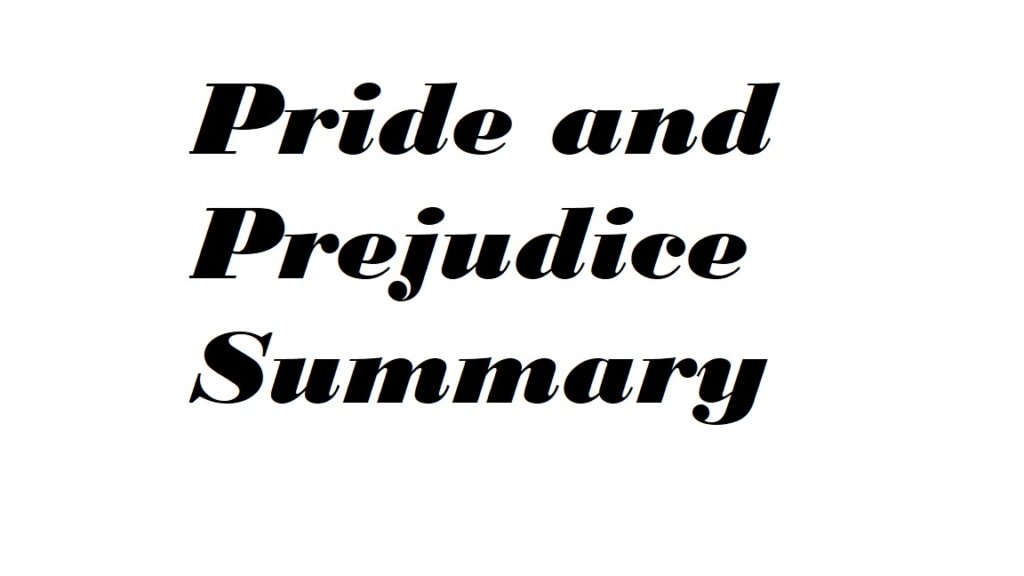Pride and prejudice is one of the most famous classical novel that exposed the different social classes in the 19th century.
Summary of Pride and Prejudice
The story primarily follows the spirited and intelligent Elizabeth Bennet as she navigates the challenges of finding love and happiness in a society where social status holds significant importance.
Set against the backdrop of the Regency era, the novel explores the lives of the Bennet family, particularly focusing on the five Bennet sisters and their mother’s relentless pursuit to see them married off well. When the wealthy and aloof Mr. Darcy enters their lives, his initial pride and Elizabeth’s quick prejudice against him set the stage for a tumultuous relationship that evolves throughout the story.
Through a series of misunderstandings, societal pressures, and personal growth, Elizabeth and Mr. Darcy gradually come to understand and appreciate each other’s true characters. As the narrative unfolds, the novel skillfully critiques the rigid social norms of the time while also celebrating the power of love and personal integrity.
“Pride and Prejudice” remains a beloved classic for its witty dialogue, memorable characters, and timeless exploration of themes such as pride, prejudice, and the complexities of human relationships. Austen’s keen observations of society and her sharp wit continue to captivate readers, making this novel a timeless masterpiece of English literature.
“Pride and prejudice” theme
“Pride and Prejudice” explores a variety of themes that are still relevant today. Some of the key themes in the novel include:
Social Class: The novel delves into the rigid social hierarchy of 19th-century England and the impact of social class on personal relationships, marriage prospects, and societal expectations.
Love and Marriage: Austen examines different facets of love and marriage, including the importance of mutual respect, understanding, and genuine emotional connection in contrast to purely practical or superficial considerations.
Prejudice and Misjudgment: The title of the novel itself highlights the themes of pride and prejudice, emphasizing the dangers of making hasty judgments based on appearances or social status.
Personal Growth and Character Development: Characters in the novel undergo significant personal growth and transformation, learning from their mistakes, challenging their prejudices, and evolving into better versions of themselves.
Female Independence: Through characters like Elizabeth Bennet, Austen explores the idea of female independence, intelligence, and agency in a society that often limited women’s opportunities and choices.
Family Dynamics: The relationships within the Bennet family and other families in the novel shed light on themes of family dynamics, parental influence, sibling relationships, and the impact of family background on individual lives.
Satire and Irony: Austen employs satire and irony to humorously critique the manners, behaviors, and societal norms of her time, offering a sharp commentary on the absurdities and hypocrisies of the society in which her characters operate.
Personal Integrity and Ethics: Themes of personal integrity, honesty, and ethical behavior run throughout the novel, highlighting the importance of staying true to oneself and maintaining moral values in the face of societal pressures.
By skillfully weaving these themes together with engaging characters and a compelling narrative, “Pride and Prejudice” continues to resonate with readers across generations, offering timeless insights into human nature, relationships, and society.
Pride and Prejudice plot
“Pride and Prejudice” by Jane Austen follows the story of Elizabeth Bennet, the second eldest of the five Bennet sisters, as she navigates the societal norms, romantic entanglements, and personal growth in early 19th-century England. The plot unfolds as follows:
The Bennet family resides at Longbourn estate, where Mrs. Bennet is eager to see her daughters married off to wealthy suitors due to the lack of a male heir to inherit their property.
When the wealthy and seemingly arrogant Mr. Bingley moves into the neighborhood, he takes an immediate liking to the eldest Bennet sister, Jane.
Mr. Bingley’s friend, the proud and aloof Mr. Darcy, develops an interest in Elizabeth, but his initial reserved demeanor and perceived arrogance lead Elizabeth to form a negative opinion of him.
As the story progresses, misunderstandings, societal expectations, and the interference of various characters complicate the relationships between the Bennet sisters and their suitors.
Elizabeth’s sister Lydia’s reckless behavior and elopement with Mr. Wickham cause a scandal that threatens the family’s reputation.
Through a series of events and revelations, including Mr. Darcy’s proposal and subsequent letter explaining his actions, Elizabeth begins to reassess her feelings towards him.
Eventually, Elizabeth and Mr. Darcy overcome their pride and prejudice, acknowledge their mutual affection, and find their way to a heartfelt and well-deserved happy ending.
The novel masterfully weaves together themes of love, social class, personal growth, and societal expectations against the backdrop of Regency-era England. Through the witty dialogue, complex characters, and intricate plot twists, “Pride and Prejudice” remains a timeless classic that continues to captivate readers with its enduring exploration of human relationships and the complexities of love.
Find us on Facebook
Practice Digital SAT
Read pride and prejudice free online
Questions about pride and prejudice
Question: Who is the author of the novel “Pride and Prejudice”?
Answer: Jane Austen.
Question: What is the setting of “Pride and Prejudice”?
Answer: The novel is set in rural England during the early 19th century.
Question: Who are the two main characters in “Pride and Prejudice”?
Answer: Elizabeth Bennet and Mr. Darcy.
Question: How does Mr. Darcy initially come across to Elizabeth Bennet?
Answer: Mr. Darcy is initially perceived as proud and arrogant by Elizabeth Bennet.
Question: What role does social class play in “Pride and Prejudice”?
Answer: Social class and status are significant themes in the novel, influencing relationships and character interactions.
Question: How does Elizabeth Bennet’s opinion of Mr. Darcy change throughout the novel?
Answer: Elizabeth’s opinion of Mr. Darcy evolves from disdain and prejudice to love and respect as she learns more about his true character.
Question: Who is Mr. Bingley’s close friend in “Pride and Prejudice”?
Answer: Mr. Darcy is Mr. Bingley’s close friend in the novel.
Question: What role do the Bennet sisters play in the plot of “Pride and Prejudice”?
Answer: The Bennet sisters, especially Elizabeth and Jane, are central to the story as they navigate love, marriage, and societal expectations.
Question: How does the theme of marriage feature in “Pride and Prejudice”?
Answer: Marriage is a central theme, highlighting societal pressures, love, financial considerations, and individual desires.
Question: What are some key events that lead to the resolution of conflicts in “Pride and Prejudice”?
Answer: Events such as misunderstandings, revelations of character, and acts of humility and love contribute to the resolution of conflicts in the novel.
Questions with answers
Question: What is the significance of the Meryton ball in “Pride and Prejudice”?
Answer: The Meryton ball sets the stage for various interactions between characters, introduces Mr. Bingley and Mr. Darcy to the community, and sparks initial romantic interests.
Question: How does the proposal scene between Mr. Darcy and Elizabeth Bennet unfold in “Pride and Prejudice”?
Answer: Mr. Darcy’s first proposal to Elizabeth is characterized by his declaration of love and criticisms of her family, leading to Elizabeth’s rejection of his proposal.
Question: What role does Lydia Bennet play in the unfolding events of “Pride and Prejudice”?
Answer: Lydia’s reckless behavior and elopement with Mr. Wickham create a major scandal that impacts the Bennet family’s reputation and relationships.
Question: How does the visit to Pemberley influence Elizabeth’s feelings towards Mr. Darcy in “Pride and Prejudice”?
Answer: The visit to Pemberley allows Elizabeth to see Mr. Darcy’s true character and the extent of his wealth and generosity, which contributes to her changing feelings towards him.
Question: Describe the crucial letter that Mr. Darcy writes to Elizabeth in “Pride and Prejudice.”
Answer: In the letter, Mr. Darcy explains the truth behind Wickham’s character and actions, clarifies misunderstandings, and reveals his own emotions towards Elizabeth.
Question: What leads to the eventual resolution of misunderstandings between Mr. Darcy and Elizabeth in “Pride and Prejudice”?
Answer: Open communication, reflection on past actions, and mutual understanding contribute to the resolution of misunderstandings between Mr. Darcy and Elizabeth.
Question: How does the relationship between Jane Bennet and Mr. Bingley develop in “Pride and Prejudice”?
Answer: Misunderstandings and interference from others temporarily separate Jane and Mr. Bingley, but their love eventually triumphs as they reunite and reconcile.
Question: What role does Lady Catherine de Bourgh play in the events of “Pride and Prejudice”?
Answer: Lady Catherine de Bourgh represents societal expectations and opposition to Elizabeth and Mr. Darcy’s potential relationship, adding conflict and tension to the story.
Question: How does the novel “Pride and Prejudice” conclude?
Answer: The novel concludes with multiple marriages, including those of Elizabeth Bennet and Mr. Darcy, Jane Bennet and Mr. Bingley, bringing resolution to the various plotlines and conflicts.
Question: What lessons about pride and prejudice do characters learn throughout the novel?
Answer: Characters learn the dangers of making hasty judgments based on pride and appearances, and the importance of humility, self-awareness, and open-mindedness in relationships and society.

